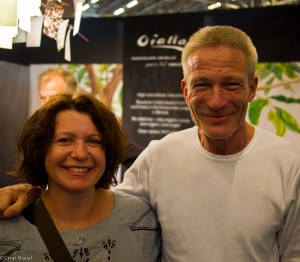[This post was from early November 2011, but was delayed due to difficulty from posting from Madagascar, which has unreliable power and internet services! Stay tuned for the Madagascar reports coming soon.]
We all drove up in the alps to a place called Voiron which is the home of Stephane Bonnat and the House of Bonnat. Clay Gordon had made the introduction, and Mr. Bonnat himself called us after Cyrus left a message in French on his answering machine. It was pretty amazing to me that we would meet the man behind some of my favorite chocolate.
When we got to his shop we were invited to wait in his office, which had the feel of some undetermined era. There were old family photos on the wallpapered wall and other paraphernalia collected over the decades including framed chocolate bar wrappers and what appeared to be a golden ticket! When Br. Bonnat entered the room through a creaky wooden door in the back of his office, he explained that the door suffered some damage from a storm that blew through the town the night before. “It’s the only thing that’s happened around here in 100 years”, he said jokingly.
Mr. Bonnat is 4th in line to run his family’s chocolate company. His great grandfather started it in 1884 and it is the oldest family run chocolate company in France. Stephane Bonnat takes the tradition of chocolate making very seriously. In excellent English, he told us that one of his goals is to make chocolate that creates the feeling of nostalgia by allowing people to taste what their parents had tasted: “the first time you eat chocolate, it leaves an indelible mark” he said “and I want people to experience that every time”. As we were listening to Mr. Bonnat, he was beginning to leave an indelible mark on us too — that perhaps this was Willy Wonka in the flesh.
 Stephane Bonnat is highly energetic and enthusiastic about everything. He believes that great chefs need to be interested in many things (He is crazy about chocolate but he also loves riding motorcycles and traveling). It is this curiosity that triggers his imagination because “chocolate is imagination”. He is also a bit of of a mad scientist drawing his inspiration from antique chocolate making equipment which he collects and restores. As we walked around the factory floor, he would point to a machine and say, “this is another old new machine I bought”. He believes that old equipment makes better chocolate and after years of loving his chocolate, I am in full agreement.
Stephane Bonnat is highly energetic and enthusiastic about everything. He believes that great chefs need to be interested in many things (He is crazy about chocolate but he also loves riding motorcycles and traveling). It is this curiosity that triggers his imagination because “chocolate is imagination”. He is also a bit of of a mad scientist drawing his inspiration from antique chocolate making equipment which he collects and restores. As we walked around the factory floor, he would point to a machine and say, “this is another old new machine I bought”. He believes that old equipment makes better chocolate and after years of loving his chocolate, I am in full agreement.
 In the Roald Dahl book, the character of Willie Wonka is paranoid about spies and infiltrators who want to steal his recipes. Stephane Bonnat is very open about his chocolate. He gave us a full tour of his facilities and even told us the ratio of beans to sugar and cocoa butter that he uses in his bars. He is however, suspicious of chocolatiers who make claims to having the best chocolate in the world, namely some unnamed Italians. In his opinion, the difference between French and Italian chocolate is that “the French are innovators and the Italians are followers” To him, the proof of the pudding is in the tasting, or in the taste of the chocolate, in this case. The Bonnat family has been making chocolate for 137 years and that’s a long time to perfect a recipe!
In the Roald Dahl book, the character of Willie Wonka is paranoid about spies and infiltrators who want to steal his recipes. Stephane Bonnat is very open about his chocolate. He gave us a full tour of his facilities and even told us the ratio of beans to sugar and cocoa butter that he uses in his bars. He is however, suspicious of chocolatiers who make claims to having the best chocolate in the world, namely some unnamed Italians. In his opinion, the difference between French and Italian chocolate is that “the French are innovators and the Italians are followers” To him, the proof of the pudding is in the tasting, or in the taste of the chocolate, in this case. The Bonnat family has been making chocolate for 137 years and that’s a long time to perfect a recipe!
Some things we learned about our visit to the Bonnat shop and Factory:
1. His dad started making single origin bars in the 80’s, which was revolutionary at the time.
2. They support programs in Peru to reduce cocaine production by having farmers plant cocoa trees instead of growing coca.
3. They still produce a complete line of Bon bons and pastries which they sell in their tea and chocolate shop in Voiron.
4. They have 2 retail locations in Tokyo that are run by local partners.
5. He uses organic and kosher milk powder in his milk chocolate bars.
6. Bonnat is very concerned about allergens. He doesn’t add soy lecithin to chocolate and his dark chocolate bars are made in a special room to avoid cross contamination.
Thanks to Clay for the introduction, and thanks to Mr. Bonnat and the House of Bonnat for their hospitality. We really loved our visit. Vive Bonnat!





























































